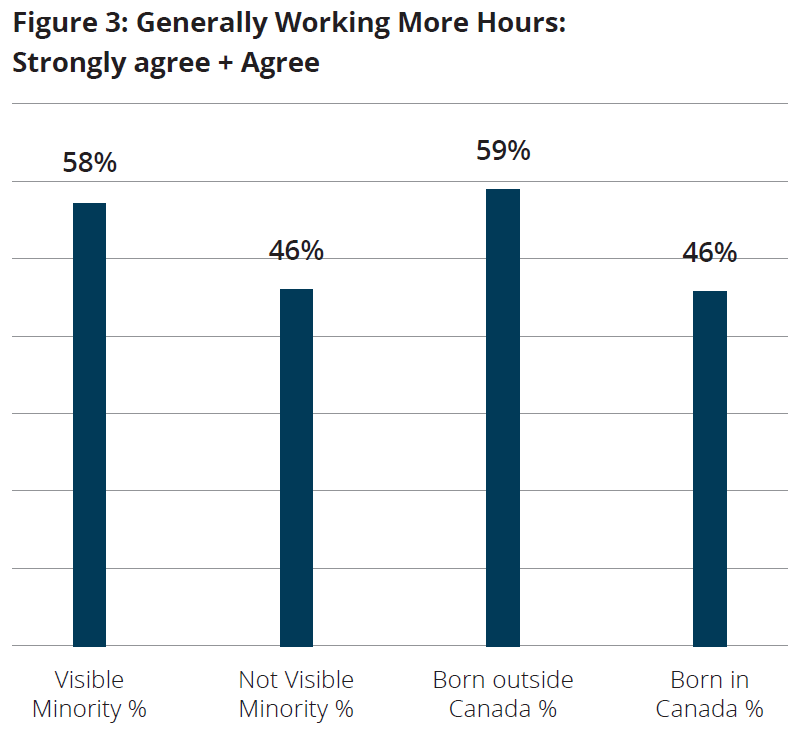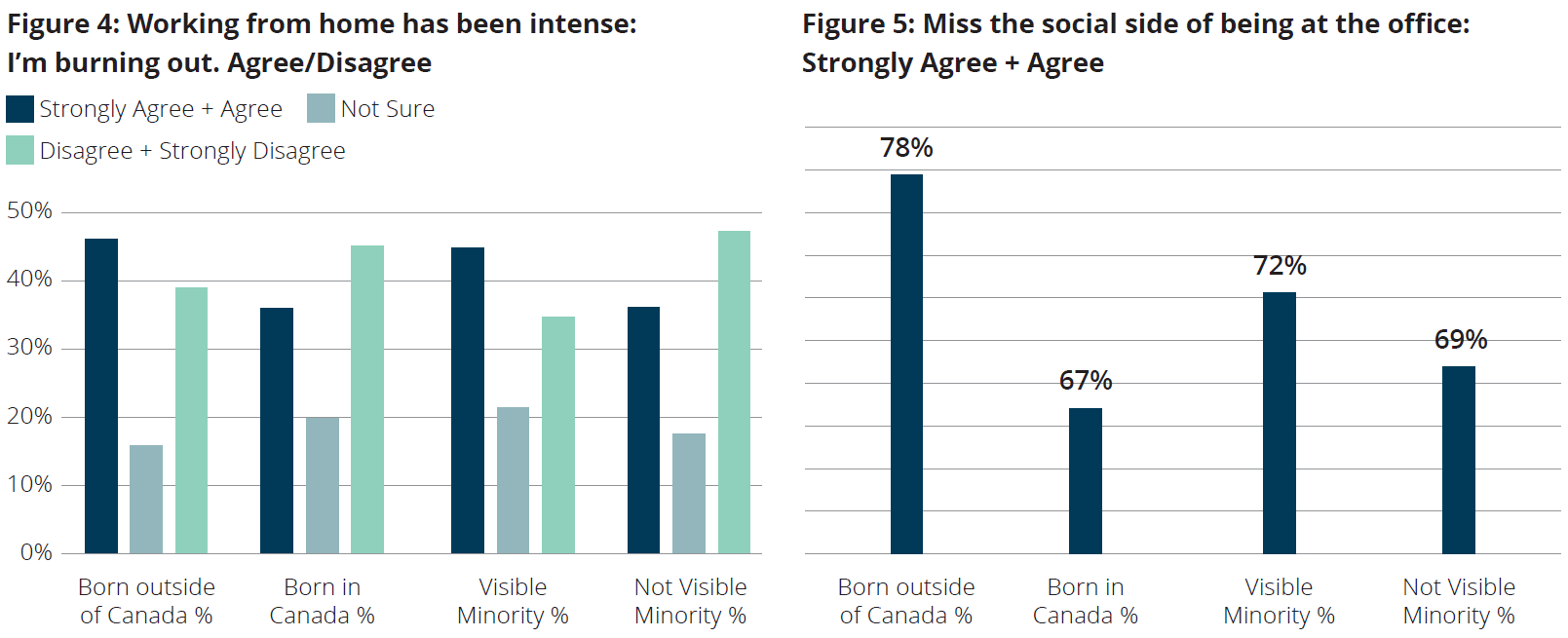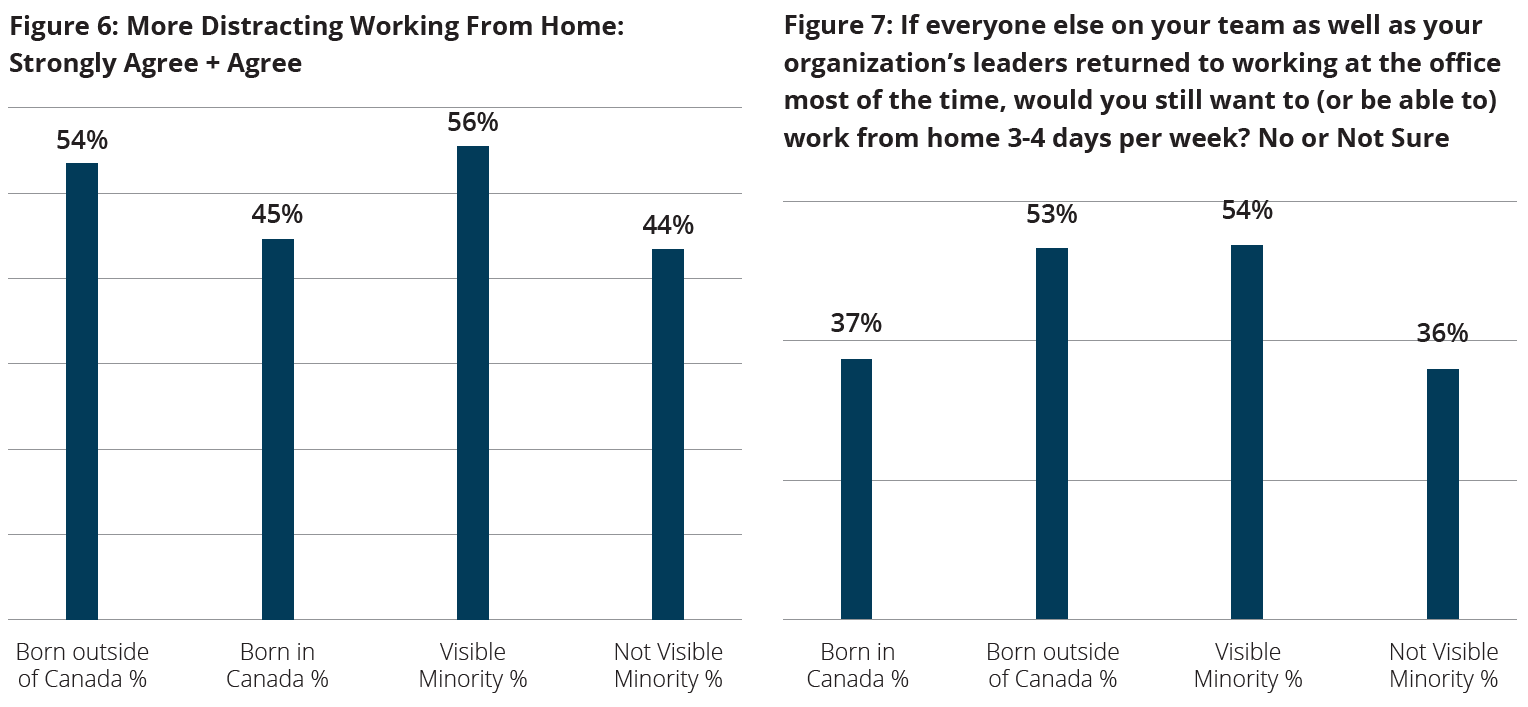
The Role of Office Space in Supporting Diversity, Equity and Inclusion: Working From Home has Unintended Consequences
Survey results reveal that immigrants and visible minorities in Canada are more likely to have found working from home challenging and stressful. Yet, along with women, they are also more likely to want to work from home more post-pandemic. This has implications for efforts to improve Diversity, Equity and Inclusion in the workplace.
Key Findings and Concerns
COVID-19 has revealed inequities in society. In Canada, as in many countries, people of colour and immigrants have often been more exposed to COVID-19 than other groups, likely from their work or that of a household member.1 Women have had a similar COVID-19 experience in terms of cases as men, but have lost jobs and left the labour force in greater numbers, whether through layoffs or for family-care reasons.2
In GWLRA’s recent survey of office workers (done with the help of Abacus consulting)3, immigrants, visible minorities and women were more likely to report challenges working from home--yet also more likely to have a greater interest in working from home the majority of the time post-pandemic. The overall differences in answers between visible minorities and immigrants versus other Canadians were modest, indicating a reasonable amount of equality within Canada. Nevertheless, a gap remains, as the charts below reveal. Not everyone has an equal capacity to have a productive workplace at home. Some office-based employers have expressed an interest in continuing to have a large percentage of employees working from home post-COVID-19. It is often framed as being a benefit to workers, or in response to current employee demands in an era of COVID-19 fears. However, our survey results suggests that for some companies there could be negative implications for diversity, equity and inclusion within their organizations.

Potentially Significant Implications:
Anticipated and announced post-COVID-19 corporate workforce policies, such as welcoming more working from home and overall flexibility, may have unintended negative consequences for diversity, equity and inclusion. This is particularly relevant to individuals looking for professional development and career advancement (it may be less concerning for employees in more static roles). If visible minorities, immigrants and women have a greater likelihood of choosing to work from home—whether full time or the majority of the time—it could reverse progress, or exacerbate differences, in promotions, leadership roles and pay equity. Consider that in many workplaces these groups combined are already the minority compared to white males; an overall increase in their working from home could amplify this difference.
Given that a significant percentage of the population in Canada’s major cities are immigrants and/or visible minorities, understanding how these groups have fared during COVID-19 is essential. For example, 47% of the Toronto Metro Area’s population is foreign born and 56% identify as visible minorities. Their inclusion in the workplace is vital if Toronto’s economy is going to continue to thrive (and require office space). For Metro Vancouver the numbers are only slightly lower (42% foreign born and 53% identify as a visible minority). With a higher percentage of women having university-level education than men, they are an essential talent pool for office-based companies. In this talent-scarce world, engaging everyone regardless of gender, ethnicity, or place of birth is essential for a productive economy. If white, Canadian-born males are more likely to work from the office, it could amplify their voices at the expense of the others.

Survey Details: Propensity to Struggle
Both immigrants and visible minorities report working more hours during the pandemic—from home—than their white and Canadian-born counterparts, as shown in Figure 3. (There were not significant differences between male and female responses to this question.) Immigrants were more likely to report that they were burning out (Figure 4). According to the latest census data, immigrants typically have more education than Canadian-born workers, so it could be their roles are more analytical, which sometimes is more project based and less clock based.4
Both immigrants and minorities also reported a more distracting work environment at home than at the office, which likely contributes to the burn out (Figure 6). Intriguingly it was men and not women who struggled with distractions at home when only gender was is considered and not ethnicity or place of birth.

All office workers, including immigrants and minorities, were highly likely to report missing the social side and the overall experience of going to the office, but immigrants (and women) more so than other Canadians (Figure 5). Although we did not ask why in this survey, possible reasons include feeling more productive at the office and the office offering a means to integrate into Canadian society.
Most surprising, despite being more likely to have an inferior working-from-home experience, and being equally or more likely to miss the office, minorities and immigrants are more likely to say they would prefer to spend more time working from home post-COVID-19.5 Although women did not report extra challenges working from home in this February survey (they did in our May 2020 survey), they are also more likely to prefer working from home post-COVID-19 than men. We should note that over one third of office workers overall, and over half of immigrants and visible minorities, report that they could not or are not sure if they could work remotely if their company leadership or immediate team were also at the office (Figure 7). It may be that some in this group are more aware of the professional development consequences of working remotely if others are not doing so. Working from home does allow for cost savings, including commuting expenses as well as potentially the costs of professional wardrobe or buying daily lunches. Before or after school care may also be a consideration.

Working from home: Will it undermine DEI in the workplace?
These findings have implications for Diversity, Equity and Inclusion in the workplace. This is especially likely for companies with employees empowered to think creatively, solve problems, or do analysis as part of larger teams. The office provides an opportunity to include everyone in decisions, in corporate culture, and in conversations. Working together also allows people to learn from one another and appreciate and benefit from different backgrounds and life experiences when building a business strategy or in problem solving. Not having minorities, immigrants and women in the office at the same frequencies as others could make it harder to hear their voices, which are valuable. Companies with diverse boards and teams outperform.
Most people learn from informal time with peers and leaders—those chats in the kitchen, or a spontaneous walk for coffee—as well as from formal meetings. When the majority are working in the same room or office and one or two individuals are not, it reduces the ease at which they are heard. Specific efforts to include those working remotely can and should be adopted, however this can be difficult. For formal meetings in a video-conferencing-enabled space, it’s manageable. But at other times, it is difficult.6 Remote workers will still miss out on those informal learning, collaborative and networking opportunities that happen spontaneously when people are in the same place. For most companies, the office will remain a valuable space for building an organizational culture, fomenting bonds between employees, and team building even if not everyone reports there everyday.
We do note that remote work in a few instances may help expand or preserve diversity. Some companies are hoping that offering more remote work flexibility will help them keep some workers--particularly women–when their life circumstances change such as having children. Keeping their voices and perspectives within the company, even if less visible, is seen as preferable to losing them. Organizations with operations located in less-diverse metro areas are anticipating that adding remote working options will give them access to a wider variety of talent, including language skills and backgrounds.
A challenge and opportunity for office tenants—and landlords—post-COVID-19 is to find ways to ensure everyone feels welcome at the office. That is, ensuring that those choosing to work from home are doing so for lifestyle reasons and not because they feel excluded. At the building level, GWLRA is analyzing ways landlords can help meet the needs of all who work in the building, as well as ensure everyone feels welcome; this includes immigrants, visible minorities and women as well as others who present differently, or who have different challenges. Events to facilitate cultural sharing is one option being considered, such as sponsoring activities on days of significance to particular cultures.
Hosting speakers or providing supportive services for newer Canadians and newcomers to the city is another option.
An immigration lawyer might help navigate family sponsorship while an expert on the local school systems could benefit immigrants and domestic migrants alike. Celebrating PRIDE week in the office might help those with gender diverse identities feel more welcome and those uncomfortable with this diversity learn more about it.
Office buildings can help workers in the building to connect to others who may work for different companies. Having friends in the building may increase the desire to work from the office. In GWLRA’s most recent Tenant Satisfaction Survey, tenant employees expressed an interest in guest speakers, yoga, book clubs and board game clubs; these are all means to connect with others. Myriad other options exist to make people feel more welcome and support them in their work and personal lives.
GWLRA remains committed to helping our office tenants return and thrive post-COVID-19. Finding ways to ensure immigrants, minorities and women feel comfortable in the workplace is essential for Canada’s economy and society, which in turn supports office demand.
1 John Paul Tasker, More racially diverse areas reported much higher numbers of COVID-19 deaths: StatsCan, CBC, 10 March 2021.
2 The Canadian Press, “Women exiting workforce faster than men, childcare playing big role, study says,” 19 November 2020.
3 Survey of 921 Canadian office workers; conducted February 2021 by Abacus Consulting exclusively for GWL Realty Advisors between January 29 and February 3 2021. The margin of error is +/- 3.2% 19 times out of 20.
4 Feng Hou, Yao Lu and Christoph Schimmele, Recent Trends in Over-education by Immigrant Status. Statistics Canada, December 2019
5 Some respondents may be anticipating that working from home post-pandemic will be less distracting as children will be in school and others in the household may be at work or other activities during the day.
6 Sid Sijbrandij, “Hybrid Remote Work Offers the Worst of Both Worlds,” Wired 7 Dec 2020.
Wendy Waters
Vice President, Research Services & Strategy
E: Wendy.Waters@gwlra.com
Michael Bansil
Vice President, Business Excellence & Innovation (and GWLRA Equity, Diversity & Inclusion Program Leader)
E: Michael.Bansil@gwlra.com

GWL Realty Advisors Inc. generates value by creating vibrant, sustainable communities that engage, excite and inspire. As a leading Canadian real estate investment advisor, we offer asset management, property management, development and specialized advisory services to pension funds and institutional clients. Our diverse portfolio includes residential, industrial, retail and office properties as well as an active pipeline of new development projects.